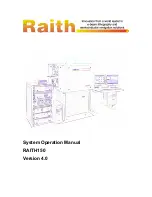
101
A. Performance Considerations
A.1 Testing, One Two …
Video professionals simply do not leap into new environments blindly. They prepare, plan, plan some
more, and then – most importantly – they test. This allows them to tackle the really tough jobs with
confidence.
A.2 IMAG and Latency
What does the term IMAG relate to? It’s a compression of the expression “Image MAGnification.”
Typically in modern IMAG applications, video cameras supply live imagery to projection systems,
magnifying speakers and performers so that audience members further back in large venues can still see
what’s going on.
IMAG is a very tricky task at the best of times, one that calls for excellent planning, and where possible,
testing. Those designing an IMAG installation have, not just one, but
two
inter-related broadcasts to
consider – in the form of the audio and video streams.
Relativity and the Speed of Light
Wouldn’t it be nice if audio and video travelled from their respective broadcast devices at the same
speed? Then, wherever you were seated in the audience, the sound from hypothetically perfect speakers
and the video image from huge video displays co-located at the front of the auditorium would reach your
ears and your retinas at precisely the same moment!
This is not the case, however. Sound travels quite slowly – so slow, in fact, that even in relatively small
venues it reaches those in the rear of the audience noticeably later than those in the front.
In loose terms, for a mid-size auditorium 600 feet long, it takes around a half-second for the audio to
reach those in the back. For this reason, audio engineers often position speakers throughout the
‘house’, then introduce carefully considered delays by electronic means – to ensure ‘late sound’ from
front speakers does not arrive after sound from the nearest speaker to those further back.
Light, on the other hand, travels so much faster that for all intents transmission can be considered
instantaneous in the same setting. So a person in the rear will see the image on a screen at the front long
before sound from a
co-located
speaker arrives.
If transmission of the video signal from the camera lens right through to the projection screen were
instantaneous (it’s not, mind you), we’d likely need to
find
a way to delay it. Viewed in this light, a certain
amount of latency is actually “A Good Thing!”
Latency and Your Audience
“Latency” – what’s that you ask? In this context, latency refers to the time it takes for the video signal to
transit one part of the IMAG path, from camera lens to final display. Latency is usually expressed either
in milliseconds or in video “frames” (typically either 25 or 29.97 to the second.)
















































